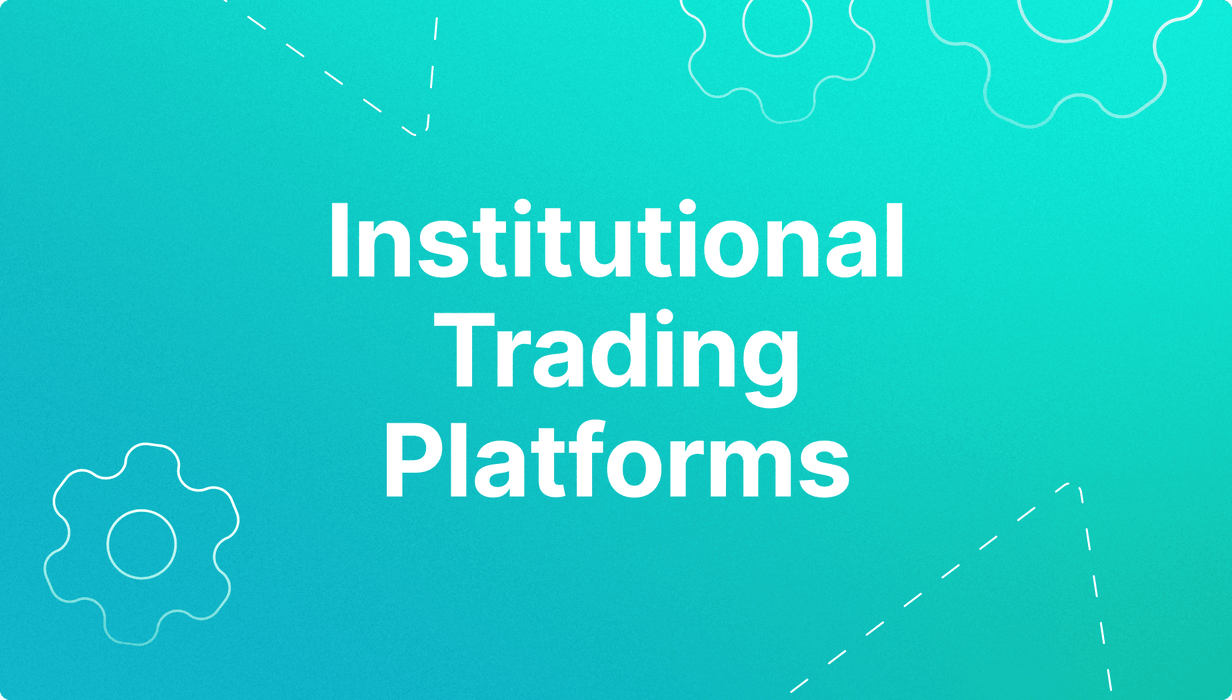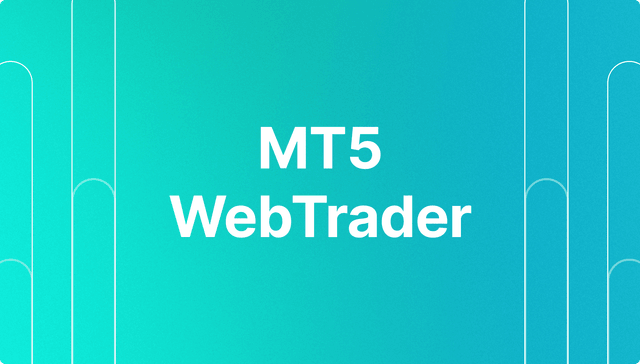Institutional Trading Platforms: Essential Features and Launch Guide

In a world where trillions of dollars circulate in the financial markets, having a powerful trading software that streamlines a pile of orders and executes them accurately is a must — here’s where institutional trading platforms shine.
So what’s the difference between them and other trading systems? Institutional trading platforms are designed for firms, market makers, and multi-market brokerages that serve a huge number of traders. Unlike retail platforms that cater to traders with limited budgets, an institution-grade trading system requires elite technical infrastructure and liquidity connections.
This article goes into the details about institutional trading platforms and how to find a reliable provider that suits your specific needs.
Have a Question About Your Brokerage Setup?
Our team is here to guide you — whether you're starting out or expanding.
What is an Institutional Trading Platform?
Institutional trading platforms are professional software to meet the complex needs of financial institutions, i.e., brokerages, market-makers, hedge funds, and multi-market players. While small-scale individual players’ retail platforms have few market orders, institutional platforms handle sheer volumes of trading at low latency, high reliability, and good scalability.

They provide best-in-class order processing and connectivity to multiple markets and liquidity venues, and integrate directly to risk and compliance systems. These systems have best-of-breed technical infrastructure, offering stability and peak performance under stress.
Institutional Trading Platform vs. Retail Trading Platforms
The key difference between retail and institutional sites is scope, execution speed, and regulations needed. Retail sites like cTrader or MetaTrader cater to tiny order sizes and provide simple tools as a result. Thus, usability and cost come above excessive speed.

On the other hand, institutional systems are engineered to process tens of thousands of transactions per second with minimal latency and optimal fills. They provide direct market access, FIX API integration, algorithmic trading capabilities, and sustainable connectivity to multiple liquidity venues.
Another key differentiator is compliance. Retail brokers can do with light KYC checks and solid verification protocols, while institutions must meet strict global standards, such as MiFID in Europe and Dodd-Frank in the US.
What are the Needs of Institutional Traders?
Institutional investors have pressing demands that go far beyond those of individual traders. They prioritise ultra-fast execution speed, tight accuracy, and comprehensive risk controls to manage large-volume orders without compromising performance and price. Therefore, when setting up an institutional trading platform, you need to ensure the following qualities:
- Advanced execution tools: The ability to execute large blocks of trades without impacting market prices and liquidity.
- Robust risk controls: Offering pre-trade checks, hedging tools, and margin calculators to prevent outsized exposure.
- Deep market data: Access to level II/III data, order book depth, and latency-sensitive feeds for accurate decision making,
- Regulatory compliance: Ensuring every trade is auditable, with automated reporting systems aligned with multiple jurisdictions.
- Scalability and uptime: The platform must handle peak volumes without downtime, as even a few seconds of failure can cost millions.
Essential Features of Institutional Trading Software
An institutional-grade trading system is evaluated by the depth of its features and its long-term sustainability. Integrating these components into your platform enables you to offer a reliable, fast, and competitive trading experience.
Direct Market Access (DMA)
DMA gives institutions the ability to send orders and interact directly with financial markets or exchange order books without relying on intermediaries. This reduces latency, provides tighter spreads, and allows for more control over execution strategies and order fill preferences.

Learn how to build, scale, and integrate a DMA trading platform with the right infrastructure, market access, and risk controls for institutional growth.
30.07.25
Advanced Order Types and Execution Algorithms
Institutions cannot rely on simple order placement strategies or major asset classes, as professional investors look for advanced order types, accurate tracking tools, and automation capabilities. These include:
- Volume-Weighted Average Price: VWAP algorithms execute trades in chunks to proportionally match the market activity, minimising impact and achieving an order price near the average market price.
- Time-Weighted Average Price: TWAP spreads orders evenly over a defined time period, ensuring predictable pacing and reducing market impact without causing liquidity spikes.
- Liquidity-Seeking Algorithms: Scanning multiple venues and markets simultaneously and routing the order in parts with the deepest liquidity and tightest spreads to minimise slippage.
- Arbitrage Engines: Exploiting price discrepancies across markets or instruments to capture risk-free or low-risk profits while also enhancing market efficiency.
Real-Time Risk Management Tools
Institutional clients deal with large orders and capital, and therefore require advanced control tools to manage market risks, exposures, and price data. As such, you must provide real-time dashboards and analytics that ensure the following:
- Pre-trade checks: Validating orders before they reach the market against position size, leverage ratios, counterparty exposure, and other parameters. This prevents risky trades that breach capital limits.
- Automated margin calls: Continuously monitoring margin levels and automatically triggering margin calls or executing hedging strategies when thresholds are breached.
- Real-time exposure dashboards: Monitoring ongoing positions using consolidated data across desks, asset classes, and geographies, giving risk managers instant visibility into exposures.

These tools protect not only the firm’s capital but also give institutional clients better data for making decisions and ensure compliance with regulatory capital requirements.
Multi-Asset Trading Capabilities
Institutions cannot operate in a selected market or selected instruments. A modern platform must support multiple asset classes and enable flexible control via a single interface. This centralised approach reduces operational complexity and increases efficiency for global trading desks, whether stocks, Forex, commodities, derivatives, or digital assets.
Deep, Reliable Liquidity Across 10 Major Asset Classes
FX, Crypto, Commodities, Indices & More from One Single Margin Account
Tight Spreads and Ultra-Low Latency Execution
Seamless API Integration with Your Trading Platform

Comprehensive Analytics and Reporting
Analytics empower better execution and oversight, and drive decision-making that is based on first-hand data and facts. Therefore, providing accurate reporting and analytics is vital for your institutional trading platform. These include:
- P&L tracking in real time: Updating profit and loss figures instantly as trades are executed, giving traders and managers a live view of performance and enabling faster responses to market changes.
- Stress-testing: Simulating extreme scenarios like market crashes, volatility spikes, or liquidity droughts to evaluate how the platform and portfolios would perform under different market conditions.
- Performance reviews: Offering detailed analytics breakdowns by strategy, asset class, or individual trader, allowing managers to identify financial strengths, weaknesses, and areas for optimisation.
- Automated reporting: Automatically generating and submitting reports to regulators and auditors, reducing the burden of manual paperwork and ensuring consistent compliance with evolving laws.
Robust Integration with Institutional Systems
A sophisticated trading platform must integrate with powerful order management systems (OMS), execution management systems (EMS), settlement platforms, and market data providers. Having a smooth ecosystem ensures flawless operations and reduces manual intervention.
FIX API and WebSocket Connectivity
The FIX (Financial Information Exchange) Protocol remains the market standard for institutional connectivity and electronic communications across financial institutions, such as broker-dealers, exchanges, and clearing houses.
FIX-enabled systems allow hedge funds, prop shops, and asset managers to directly connect automated trading systems, and WebSocket integrations provide ultra-low-latency streaming data support in specific cases. It all leads to an ultra-fast, low-latency trading environment.
B2BROKER provides FIX 4.4+ and WebSocket connectivity in B2TRADER, an ultra-fast multi-market trading system equipped with a powerful matching engine and liquidity systems, enabling institutions to have velocity and flexibility at once.
Power your Brokerage with Next-Gen Multi-Asset & Multi-Market Trading
Advanced Engine Processing 3,000 Requests Per Second
Supports FX, Crypto Spot, CFDs, Perpetual Futures, and More in One Platform
Scalable Architecture Built for High-Volume Trading

How to Launch an Institutional Grade Platform
Building an institutional trading platform is a multi-step process that requires clear objectives, careful planning, and strong partnerships.
After starting with defining the business model, you must select a suitable tech partner, build infrastructure, integrate risk management tools, test the platform, and finally establish institutional-grade liquidity connections. Here’s how you can start:
1. Define Business Objectives and Requirements
The first step in launching an institutional-grade platform is setting clear objectives. You need to determine which asset classes you plan to support, the markets you want to cover, and the scale of trading activity you anticipate.
Moreover, you must choose the jurisdiction you want to work in, based on the location, regulations, and alignment with your infrastructure. Clarifying these goals early on ensures longevity and sustainable operations.
2. Select the Right Technology Partner
Then, you need to choose a suitable technology provider, which is one of the most important decisions in the process. A reliable partner with institutional expertise, sophisticated infrastructure, and strong integrations can deliver the performance, resilience, and scalability you expect.
Find a reliable technology development company by reviewing their record, reputation, and consistency, especially when working with financial institutions.
3. Build Infrastructure and Connectivity
The next step is to build a low-latency infrastructure with robust connectivity — a prerequisite for any institutional trading platform.
This includes setting up co-location with major exchanges, offering direct market access, and supporting APIs needed for automated trading. These components support high-volume, high-speed environments and equip you with a competitive advantage.
4. Integrate Risk Management and Compliance Tools
Risk management and compliance frameworks must be embedded from the beginning. Pre-trade checks, automated reporting, and monitoring tools safeguard your capital and reputation. They also boost client trust and align with regulatory obligations in most jurisdictions.
Many brokers treat compliance as an afterthought, leading to launch delays, operational restrictions, and even financial penalties.
5. Test, Optimise, and Scale
After finishing configurations and before going live, you need to conduct rigorous tests under realistic conditions. This brings up any hidden performance gaps, technical issues, and other shortcomings that can affect the user experience.
These QA tests include stress simulations and parallel runs to ensure stability and resilience. You can also perform user acceptance testing (UAT), where the software is tested by end-customers to ensure that it meets their needs and is ready for production release.
Then, optimisation starts. You need to implement needed adjustments and improve system performance, ensuring that everything runs smoothly before launching your setup.
6. Establish Institutional Liquidity Access
Liquidity is the backbone of institutional trading, and no platform can succeed without a powerful, deep liquidity integration. Therefore, you must find reliable liquidity providers that offer access to consolidated pools, tight spreads, high fill rates, and large orders with minimal slippage.
These connections include:
- Tier-1 aggregation across FX, crypto, and CFD trading venues.
- FIX API or low-latency streaming feeds to ensure ultra-fast execution.
- Smart routing and redundancy across venues to ensure reliability.
Risk Management and Compliance for Institutional Clients
For institutional clients, risk management and compliance are not optional—they are fundamental pillars of sustainable operations. They allow institutions to operate globally without fear of hefty penalties or reputational damage while simultaneously protecting capital.
As such, you must ensure top-tier compliance and risk controls within your platform, including:
- Pre-trade checks are the first line of defence. They validate whether an order complies with capital requirements, margin limits, and client restrictions before it reaches the market. This prevents erroneous or oversized trades that could destabilise a firm.
- Trade surveillance systems operate in real time to detect patterns of market abuse, insider trading, or manipulation. Institutions must demonstrate to regulators that they have the tools to identify and act on suspicious behaviour and protect the market and their reputation.
- Automated reporting is another critical layer. Some regulators require detailed reports to be submitted within strict timeframes. Automation eliminates human error, reduces workload, and ensures that compliance is achieved without slowing down trading activity.
- Audit trails provide a permanent record of every order, amendment, and execution. Financial authorities demand full transparency and require institutions to trace any transaction from initiation to settlement.
These measures create a robust compliance infrastructure that allows institutions to expand across borders, integrate multiple asset classes, and operate with confidence in the world’s strictest regulatory environments.
2025 Trends in Institutional Trading Technology
Technology for institutional trading is evolving rapidly as user expectations change. Now there is a pressing demand for tailored solutions that enable operators to integrate FinTech solutions from a single provider, as well as white labels that reduce the time and cost of launching a fully operational trading platform.
Growing Demand for All-in-One Brokerage Services
Institutions are moving away from fragmented setups, where liquidity streams, execution engines, payment gateways, and financial settlement systems exist in isolation from one another.
In 2025, the trend is towards all-in-one ecosystems that combine these services under one umbrella. As such, operators can add payment services, order management software, market data feeds, and monitoring tools from the same provider, reducing operational friction.
This approach is also cost-efficient, as firms no longer need to maintain separate accounts and infrastructures for different tasks.
Move Toward Multi-Asset, Cross-Border Platforms
The global nature of trading urges institutions to diversify risks across securities, pushing them to provide stocks, Forex, cryptocurrencies, commodities, derivatives, and other synthetic instruments within the same interface.
This multi-asset, multi-market coverage enables traders to hedge their risks, balance their portfolios, and switch strategies seamlessly without needing to juggle multiple systems.
Moreover, cross-border functionality has become equally important. Today, firms must ensure uninterrupted trading across time zones and jurisdictions to onboard clients from various markets and regions. This comprehensive coverage allows you to unify global operations, reduce overheads, and maintain 24/7 market access.
The Rise of Prime-of-Prime and White-Label Solutions for Brokers
Prime-of-Prime (PoP) providers and white-label platforms are becoming vital for brokers who want institution-type capabilities without building infrastructure from scratch.

Building proprietary systems with direct tier-1 liquidity access is costly and time-consuming, but PoP providers allow brokers to leverage established relationships and infrastructure at a fraction of the expense.
Additionally, white label solutions allow brokers to launch branded systems rapidly, offering pre-built platforms that can be customised and prepared much faster than custom development.
In 2025, these models are gaining popularity as businesses seek to scale faster, comply with regulations more effectively, and offer their clients liquidity and technology that would otherwise be inaccessible. The result is a more competitive brokerage landscape, where even mid-sized firms can provide near-institutional levels of service.
Launch an Institutional-Grade Platform with B2BROKER
Institutional trading platforms are no longer optional—they are essential if you want to compete globally. From deep liquidity access and advanced risk tools to seamless integration and all-in-one ecosystems, building a professional platform reduces costs and improves efficiency.
B2BROKER delivers institutional-grade solutions across liquidity, trading platforms, and infrastructure, helping you to launch with confidence and start your trading services within a few weeks—not months or years.
Build an Institutional-Grade Platform Today
Access deep liquidity, advanced risk management, and seamless integrations—all in one ecosystem







